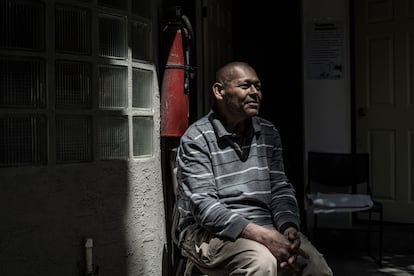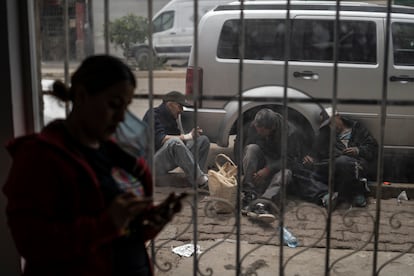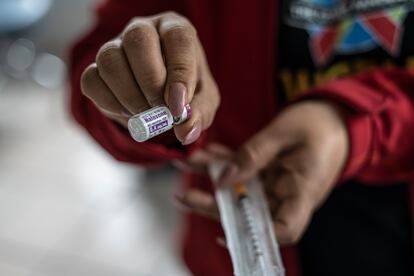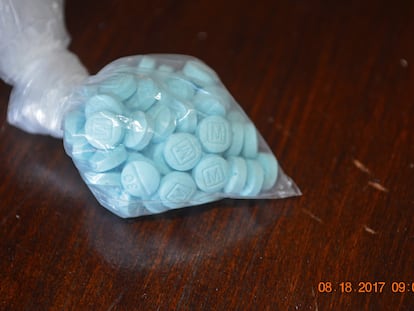Fentanyl’s lethal impact: ‘The worst part is waking up in the morning and needing a fix before I can do anything’
Five addicts tell EL PAÍS how their lives were ruined by the consumption of this cheap, highly potent drug that causes 100,000 deaths a year in the US and could trigger the next major health crisis in Mexico


Hugo Arroyo’s left arm hangs limply at his side. It was broken in two by the police when he was sleeping rough in Tijuana; he didn’t get up in time, he explains, and so was beaten. Three years have passed and he is still waiting for an operation. In the meantime, he sweeps, scrubs, prunes trees, takes out the garbage and other odd jobs with one arm: he manages, but the pain is excruciating.
“I think I’ve managed to put up with my arm pain because of the fentanyl, having it broken and going around pretending I have nothing. The doctor asked me if I was sure I wanted to have surgery because it would be a painful procedure, but I told him that it couldn’t hurt more than it does now,” he says with a shy smile. Like many in this border town, Arroyo consumes fentanyl daily. Fifty times more potent than heroin, the drug is responsible for 100,000 deaths each year in the US. There is no official data on its impact in Mexico, but experts and organizations insist that is could trigger the next big public health crisis in the country.
Exacerbating the impact of fentanyl is the fact it is extremely cheap, selling for as little as $2.5 for a hit. And it only takes a few hits to create addiction – three, say Uriel and his partner, Mari. The high is brief and withdrawal torturous, involving aching bones, migraines and gastroenteritis-type symptoms.
Fentanyl is smoked, inhaled and injected. How often depends. Three times a day is viewed by some users as an example of willpower, others can reach 10 pricks a day, and yet others simply lose count. The average number of daily doses for addicts is seven, according to government surveys. Those who use it have turned their lives into a race against the next dose.

“The worst part is waking up in the morning and needing a fix before I can do anything. My bones hurt and I can’t concentrate,” says Arroyo, 53, who was born in Uruapan, Michoacán, and migrated to the US through economic necessity, settling in California where he worked in a factory and as a dishwasher. “I worked my way up to cook,” he says proudly. He met someone and had a child, but after 20 years in the US, he was deported for drunk driving in 2013. It was his third time getting caught. Sent back to a country he no longer knew, his life went into a downward spiral.
He began taking heroin, became addicted and spent years trying to get off it with the help of methadone and rehab centers. So far, he has chalked up one success; he was working with a company collecting garbage in Tijuana’s Plaza Rio when he decided he needed rehab. Emerging after three months, he got his job back and held out for a year without using, but then the company went bankrupt. “They owed me six months’ wages,” he says. “Suddenly I found myself without a peso, and nowhere to sleep.” Fentanyl was available on the street to take the edge off his change of circumstances. The effect was like heroin, only stronger. “I had to use less, and it cost me less,” he explains. After his violent encounter with the police, he received medical care from Prevencasa, a support organization, in 2019. They have given him a room and a small maintenance job at the center. “Thanks to being here and having things to do, I don’t feel so tempted. Out there, it was one dose after another.”
Tijuana as lab
Located just a few meters from the border wall that separates Mexico and the US, Prevencasa’s courtyard has become an oasis in Tijuana. The center provides information and medical attention, clean water, a shower, therapy and new syringes to prevent sharing and infections. In this two-headed, English and Spanish-speaking city, where the currency is both pesos and dollars, addicts have become part of the urban landscape. The city is littered with rehabilitation clinics, mostly private, and religious organizations offering the famous 12-step program. At the same time, drug traffickers are refining their product to make it more addictive and easily available.
Experts no longer have any doubt that Tijuana’s vulnerable have been used as fentanyl lab rats. “Tijuana and Ciudad Juarez have functioned as a laboratory to determine doses, and how to mix fentanyl with other drugs,” says José Andrés Sumano, a researcher on drug trafficking and public security at the Colegio de la Frontera Norte (Colef), a public research center. Tijuana is one of the busiest borders in the world and has been the epicenter of fentanyl raids for years, according to reports from Mexican authorities.

The ingredients come from far afield. Most of the molecules used to create it are sourced from China and India, and arrive in Mexico through its ports or through Guatemala. Here, they are “cooked” and sent north to the US and Canada, home to the world’s biggest market. In Mexico, fentanyl is not consumed as such, but rather mixed with cocaine, heroin and crystal meth. The question is why?
“Unlike cocaine, which they have to produce in the highlands of Colombia, or heroin, which needs large opium plantations, fentanyl can be produced in a simple, small laboratory, with few chemical precursors, and does not require large facilities,” explains Sumano. “It’s so potent that just a little active ingredient can generate a lot of product. And it is highly profitable; they make much more money with fentanyl than with cocaine or heroin.”
Fentanyl has become a kind of golden goose for drug traffickers. It’s cheaper and less risky as the quantities are smaller for an equivalent hit and so can be transported with greater ease. This explains why there are now 200 deaths per day in the U.S. caused by fentanyl. A large number of those affected were consuming their habitual fix of cocaine or crystal meth into which, unbeknownst to them, fentanyl had been introduced. “Organized crime is on a learning curve,” says Sumano. “They still don’t have clear control of the doses.”

Trial and error has proved lethal, not just in the US, but also in Mexico where much of the experiments have been conducted among the vulnerable. “Between 2017 and 2018, we began to see the impact on the behavior of users just a few seconds after administration: episodes of psychosis and hallucinations,” says Lilia Pacheco, general project coordinator at Prevencasa. “It seemed strange because the same thing didn’t happen with heroin. But that happens only at the beginning. Later, the consumer appears to adapt. The other thing we are concerned about is overdoses.” The organization deals with two or three overdoses every day. José Andrés Sumano says overdoses have risen by between 200% and 400% in recent years.
Karen no longer keeps track of how many times she has overdosed since she started using fentanyl in 2020. Is it 12 or 15? She was a psychopedagogy student in Guadalajara, in the state of Jalisco, when she first tried the drug with an ex-boyfriend. “When I took fentanyl for the first time, I took about five drops through my nose,” she says. “It was like I died and then I was revived.”
After that time, many more followed; she remembers very few, but she does remember the first loaded injection: “I turned purple. They thought I was dead, they poured water on me, and suddenly I started trying to breathe like a fish. I was 24.” Referring to a large scar on her arm, she adds, “The thing with my arm was because of the injection, they put salt water on me and it got infected.” She dropped out of college with just one semester to go and now does sex work to pay for her consumption. What she longs for most, she says, is to get off drugs and out of the hole she finds herself in: “It’s horrible,” she says. “You no longer have control. The drug controls everything, it brings you to your knees, you lose your life, you lose your whole being, you are no longer you.”
“Fentanyl? What the hell is that?”
Consumption has soared in a short space of time in Mexico. In 2017, in a study called Cuqueando la chiva, involving more than 600 heroin users, only six had taken fentanyl – the rest did not even know what it was. Today, fentanyl users are the majority. “In just four and a half years, we went from establishing that people did not know what fentanyl was, to establishing that it’s the drug they look for,” explains Clara Fleiz, a researcher at the National Institute of Psychiatry and one of the first authors in Mexico to study the presence and evolution of fentanyl. “Because it is what is available. It’s what’s on the streets.”

Oscar combs his hair for the interview. Melissa paints her nails electric blue. They are young, 27 and 24, but they have been using drugs for a decade. Their drug habit has been one of progression: marijuana, cocaine, crystal meth, heroin and finally fentanyl. “About a year ago, I wanted to buy chiva [heroin] and there wasn’t any,” says Oscar. “They didn’t sell it anymore. They told me, ‘There’s nothing left but pure white china, pure fentanyl. ‘What the hell is that?’ I asked and they said, ‘It’s the same thing, only stronger, just take half of what you took before.’ And like everyone else, I got started. It’s too strong. If it’s your first time, it doubles you up,” adds Oscar just after his girlfriend has injected fentanyl into his neck. “Your body can’t take it,” clarifies Melissa.
Both Oscar and Melissa left home when they were minors, Oscar because of his mother’s beatings, Melissa after a teenage pregnancy. They lived on the street and started using. Oscar has visited rehabilitation centers several times without success; Melissa has heard so many horror stories that she won’t go. They met on a corner in downtown Tijuana a year and a half ago, and have been inseparable ever since, earning what they need for their next fix from recycling garbage and cleaning windows. Sometimes there’s enough over for a room. Melissa grew up in San Diego, where her mother and little sister still live. She says she still thinks about them a lot, but she doesn’t dare to call them, and anyway she doesn’t remember their phone number. “I’m very sad,” she says. “I’m a good bitch but I’m the black sheep, and I’m ashamed. Right now, they don’t know how I am, because I haven’t talked to them. I’m strong. But they worry a lot,” she says, dipping a chocolate cookie in her coffee, on a sofa in Prevencasa.
Today is Mother’s Day in Mexico. But it’s business as usual at the center. A full staff is on duty, welcoming migrants, consumers, tuberculosis patients. During the morning, a man comes in to ask if he can use the phone. Bald and with a thick accent, he dials a number and says: “Happy Mother’s Day, Mom.” After hanging up, he picks up his syringes and leaves. The woman in charge of the center’s reception writes down his name along with all those who come daily – around 120. “Ninety percent of those who come here are using fentanyl,” says Pacheco.

A public health crisis looms
The disaggregated figures from various non-profit organizations and researchers are the only indication of how fentanyl is impacting Mexico. There are no official figures. Andrés Manuel López Obrador’s government decided to cut the cost of the National Addictions Survey (Encodat), which had been conducted approximately every five years since 1998. The last one available is from 2016, when fentanyl was not yet readily available. The lack of data makes it difficult to respond to the problem.
Fentanyl has become the latest diplomatic issue between the US and Mexico, a hot potato that neither government wants to own. López Obrador insists that it is an “imported problem” and that there are no laboratories in the country. He also proposed banning the medical use of fentanyl in hospitals, a reaction strongly criticized by doctors since it is essential for certain procedures. In Spain, for example, it is used in a controlled way for cancer patients when experiencing acute pain. “The federal government’s strategy of denying the problem does not help at all,” says Sumano. “Nowadays, any consumer of drugs such as heroin or methamphetamine in the US or Mexico should assume that their drug is adulterated with fentanyl.”
Although in Mexico consumption remains limited to certain places, mainly along the northern border, and does not reach US levels, experts are concerned that in the future it will be mixed with crystal meth, a much more popular drug. Then there is the added complication that the main drug to curb overdoses, naloxone, is not sold in pharmacies in Mexico and must be imported. Sumano concludes: “The Mexican government has no strategy and the health crisis is just around the corner.”
The scarred hands preparing a fentanyl pipe once allowed Uriel to make a living from sport. A professional player of jai alai, Uriel, now 52, went to Miami to compete in the professional league. “I didn’t drink, I didn’t smoke, I was a sportsman,” he says with a smile. It was upon his return to Tijuana 15 years ago when he started doing drugs. He has stopped several times, the last being three years ago: “I came back because I was lonely,” he says. “I was clean but without any friends or a job. I used to ask for heroin, but it came with fentanyl. I realized because when I used it for the first time I doubled up. Now heroin doesn’t do anything for me. I’m still a bit afraid of death, so I don’t want to overdose: I only take it three times: breakfast, lunch and dinner, and then leave it until the next day.”
Sign up for our weekly newsletter to get more English-language news coverage from EL PAÍS USA Edition
